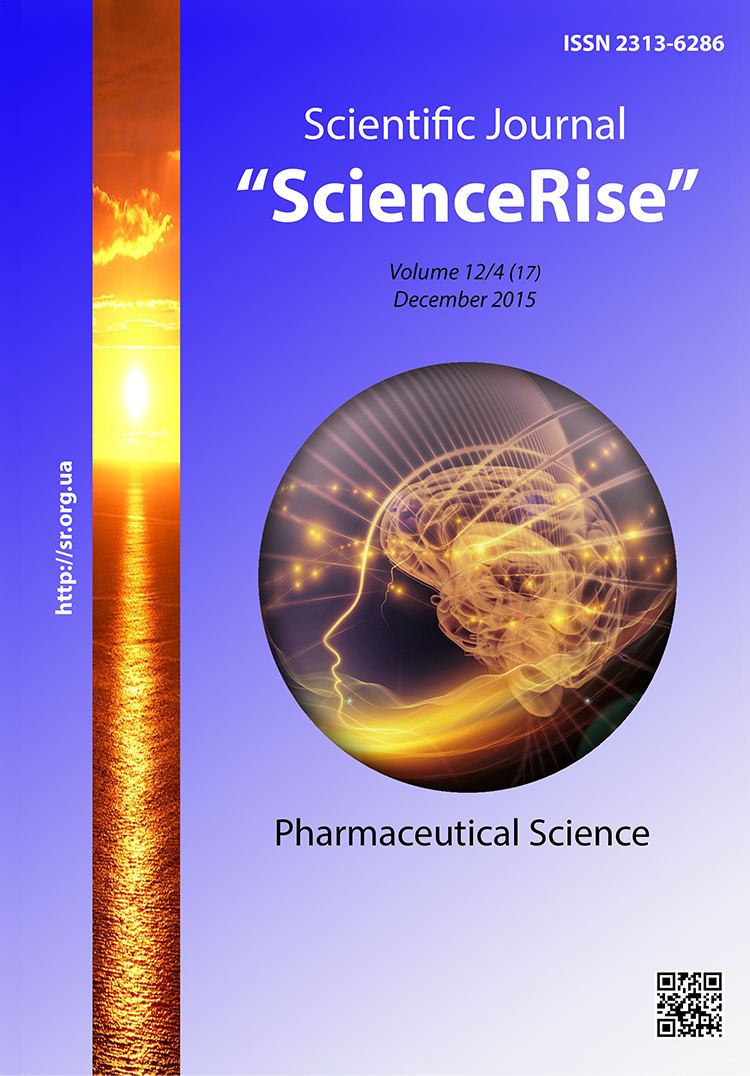Актуальність створення гомеопатичних препаратів на основі сировини рослинного походження
DOI:
https://doi.org/10.15587/2313-8416.2015.57215Ключові слова:
цикламен європейський, гомеопатія, гомеопатичні препарати, сухий екстракт, антибактеріальна, протизапальна діяАнотація
Гомеопатичні лікарські засоби впливають всебічно на організм людини. Велика кількість людей в Україні та за кордоном оцінили ефективність гомеопатичних препаратів завдяки відсутності токсичності, економічній вартості, можливості тривалого використання. Крім того, гомеопатичні лікарські засоби виготовляють з сировини природного походження, що зменшує ймовірність виникнення побічних ефектів.
На території нашої країни росте велика кількість різних видів рослин, багато з яких мають лікувальні властивості. Відомо, що понад 35 % всіх лікарських препаратів виходить з рослин, і гомеопатичні препарати не є виключенням. Так, цікавою для розробки нових гомеопатичних препаратів є лікарська рослина цикламен європейський, яка містить багато біологічно активних речовин та є мало вивченою.
Ціль. Метою нашої роботи стало вивчення показників якості сухого екстракту з лікарської рослини цикламен європейський, який пропонується використовувати для подальшої розробки гомеопатичних препаратів.
Методи. Для вирішення поставленої мети були проведені фізичні та фізико-хімічні дослідження розробленого сухого екстракту з рослинної сировини.
Результати. В результаті роботи було вивчено органолептичні показники, проведено фізико-хімічні дослідження сухого екстракту з рослини цикламен та ідентифікацію основних біологічно активних речовин.
Висновки. Одержані результати підкреслюють актуальність для вітчизняної фармації подальшого дослідження одержаного екстракту з лікарської рослини цикламен європейський та розробки на його основі гомеопатичних назальних крапель для профілактики та лікування хронічних запальних захворювань носової порожнини
Посилання
Аntjuhov, R., Moshich, О., Garnik, T. (2005). Gomeopatiya v sistemi simejnoji medicini: mignarodnij dosvid ta perspective [Homeopathy is a system of family medicine: international experience and prospects]. Journal of Pharmacy and Pharmacology, 12, 34–37.
Goossens, M., Laekeman, G., Aertgeerts, B., Buntinx, F. (2009). Evaluation of the quality of life after individualized homeopathic treatment for seasonal allergic rhinitis. A prospective, open, non-comparative study. Homeopathy, 98 (1), 11–16. doi: 10.1016/j.homp.2008.11.008
Shvabe, V. (1957). Gomeopaticheskie lekarstvennie sredstva. Rukovodstvo po opisaniyu i izgotovleniyu [Homeopathic medicines. Guide to information and manufacturing]. Moscow Scientific - Medical Society of homeopaths, 159–160.
Oleinik, S. V. (2015) Modern aspects of development and treatment of rhinosinusitis. Journal of Pharmacy, 3 (83), 67–70.
Baumgartner, S. (2014). Homeopathic basic research: state of research and quests for the future. Homeopathy, 103 (1), 62–63. doi: 10.1016/j.homp.2013.10.007
Iskenderov, G. V., Islamov, G. R. (2009). Raspredelenije ciklamelina А v organizme otravlennih givotnih [Distribution cyclamelinum A in the body of the poisoned animals]. Ukrainian biopharmaceutical journal, 3, 28–32.
Rahimova, О. L., Azarova, L. V., Rigko, V. E.,Chesnokova, І. М. (2003). Antimikrobna aktivnist’ sokiv dejakih orangerejnih roslin [Antimicrobial activity of some juices greenhouse plants]. Journal of the National University of Odessa, 1, 177–182.
Оlejnik, S. V., Tihonov, О. І. (2012) Doslidgennya stabil’nosti gomeopatichnih preparativ na osnovi likars’koji roslini ciklamen evropejs’kij [Investigation of stability of the homeopathic medicines on the basis of cyclamen europaeum medicinal plant]. Journal of Pharmacy, 4 (72), 15–18.
Dergavna Farmakopeya Ukrajini (2001). [State Pharmacopoeia of Ukraine]. First edition, Kharkiv: RIREG, 556.
Dergavna Farmakopeya Ukrajini (2009). [State Pharmacopoeia of Ukraine]. First edition, supplement 3, Kharkiv : State Enterprise " Ukrainian Scientific Center of Quality pharmacopoeia of medicines ", 280.
##submission.downloads##
Опубліковано
Номер
Розділ
Ліцензія
Авторське право (c) 2015 Світлана Валентинівна Олійник

Ця робота ліцензується відповідно до Creative Commons Attribution 4.0 International License.
Наше видання використовує положення про авторські права Creative Commons CC BY для журналів відкритого доступу.
Автори, які публікуються у цьому журналі, погоджуються з наступними умовами:
1. Автори залишають за собою право на авторство своєї роботи та передають журналу право першої публікації цієї роботи на умовах ліцензії Creative Commons CC BY, котра дозволяє іншим особам вільно розповсюджувати опубліковану роботу з обов'язковим посиланням на авторів оригінальної роботи та першу публікацію роботи у цьому журналі.
2. Автори мають право укладати самостійні додаткові угоди щодо неексклюзивного розповсюдження роботи у тому вигляді, в якому вона була опублікована цим журналом (наприклад, розміщувати роботу в електронному сховищі установи або публікувати у складі монографії), за умови збереження посилання на першу публікацію роботи у цьому журналі.

